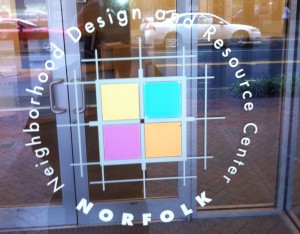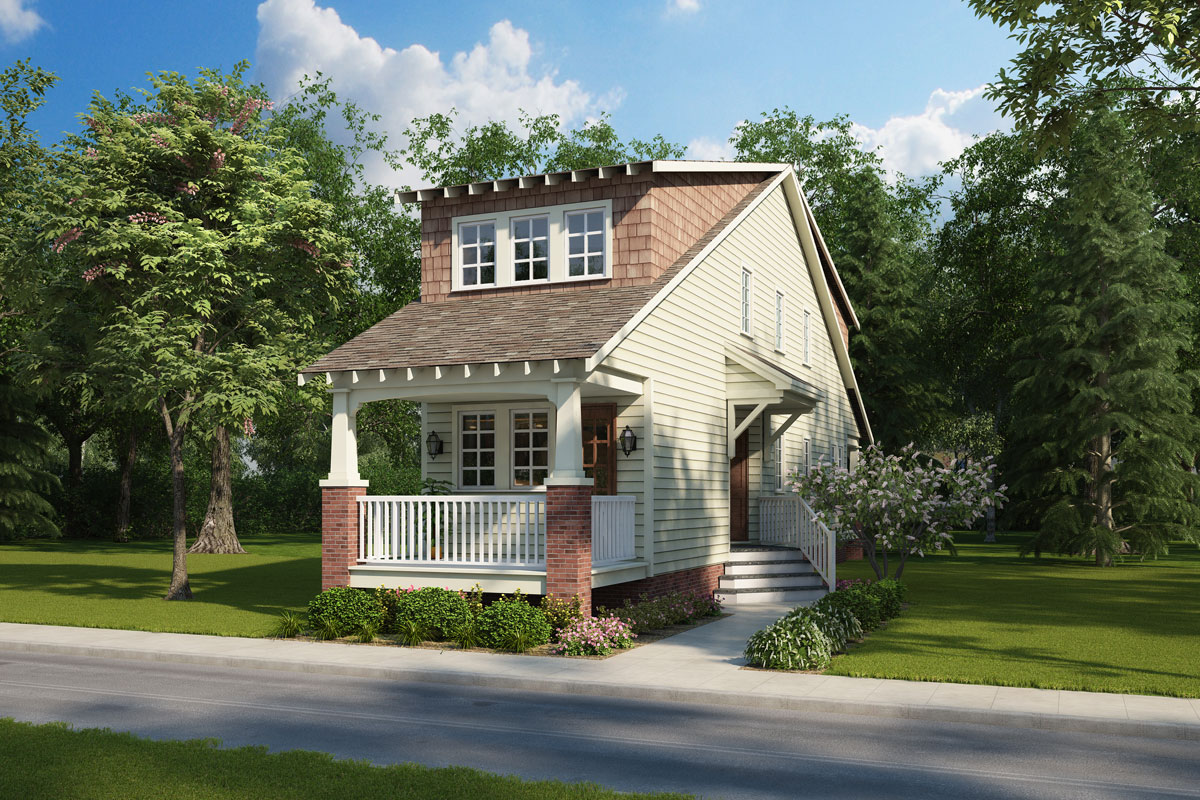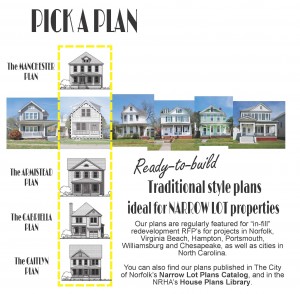You are currently browsing all posts tagged with 'narrow lot'.
12 FOOT WIDE HOUSE PLAN FOR A NARROW URBAN LOT
posted on Wednesday, December 7th, 2016 at 11:48 am12 FOOT WIDE HOUSE PLAN FOR A NARROW URBAN LOT
This 12 foot wide house plan (The Pencil) features 2 bedrooms and 2 1/2 baths. It is designed for the unusual situation when a severely limited lot condition requires a home to be just 12 feet wide. Such plans can be quite livable as witnessed in the Canton neighborhood of Baltimore, MD, where such narrow homes touch their neighbor’s properties to become urban row houses.
FIRST FLOOR LAYOUT
The side entrance allows for optimal use of the living space. The front family room opens out onto a covered porch while the dining room opens out onto a private deck. The plan includes a first floor laundry room perfect for today’s busy life style. The staircase is located in the center of the structure. This allows for the maximum natural light in the living areas
SECOND FLOOR LAYOUT
The upstairs bedrooms are situated at either end of the structure with access to their own bathroom. The master bathroom being en suite. The guest bathroom being accessible from both the hallway and the guest bedroom.
To purchase this plan visit us at www.gmfplus.com/stock-plans/
#12footwide #narrowlot #urbaninfill
Tags: 12 foot house plan, 12foothouseplan, narrow lot, narrowlot, urban infill
HISTORICALLY APPROPRIATE HOUSE PLANS FOR URBAN INFILL PROPERTIES
posted on Tuesday, May 7th, 2013 at 10:21 amAmong the blight clearance strategies of a Redevelopment and Housing Authority they routinely purchase properties that are in poor condition or foreclosed or otherwise unsuitable for the health, safety and welfare of a neighborhood. This approach is especially effective when contiguous properties are involved and it can implement several houses at a time to replace deteriorated housing stock with new affordable construction.
In many cases an RHA finds itself with an opportunity to call for new homes to be built in a similar architectural style as the historical character of the existing neighborhood. This is accomplished by publishing Requests for Proposals (RFP’s) asking for builders and/or developers to use certain pre-selected plans. The plans come from portfolios where independent architects publish ready-to-build editions of historically appropriate traditional neighborhood designs.
Many urban homes were originally built on the small narrow lots platted in the early 1900’s. Some of these house plans came from pattern-book catalogs such as Sears and Roebuck. It is appropriate that a replacement house plan, a century later, should come from a similar catalog of plans. The character of the old neighborhood can be retained with this strategy of individual lot infill projects.
GMF+ attended the Virginia Association of Housing and Community Development Officials VAHCDO conference in May 2013 in Virginia Beach. It provided a vendor table display at the event where a catalog of its historical urban infill house plans was available. The same plans can be seen on this website as NARROW LOT PLANS. These plans are regularly featured in RFP’s for in-fill projects in Norfolk, Virginia Beach, Portsmouth, Williamsburg and Chesapeake, as well as cities in North Carolina.
Tags: infill, narrow lot, Neighborhood, Norfolk, PHA, plans, RHA, TND, urban, VAHCDO
Traditional Neighborhood Design in Winfall, NC
posted on Saturday, October 29th, 2011 at 8:04 pmCommunity Development Corporations are commonly not-for-profit organizations incorporated to provide programs, offer services and/or engage in other activities that promote and support community development. CDCs typically serve a geographic location such as a neighborhood or a town.
Such is the case for the Northern Community Development Corporation of North Carolina, serving the rural counties and communities of northeastern NC. In 2009 it partnered with the Black Family Land Trust to fund the planning and startup administration for an affordable housing project in Winfall NC. Private land on the Perquimans River was committed to the development, to be marketed to individual homeowners, 50% market rate, 50% affordable. A portion of the project site existed as a community park, boarded by the Windfall Town Hall building with an additional 3 acres of vacant land, formerly a slag dump, surrounded by neighboring farms and homestead properties.
The project met the mission objectives of the sponsoring non-profit entities: for NCDC, to increase low income housing opportunities and workforce homeownership; providing equitable socio-economic opportunities for minority populations. It also met the land conservation objectives of the Black Family Trust to provide educational, technical and financial services to ensure, protect, and preserve African American land ownership.
With the property pledged to the project, funds were allocated by the partnership to hire an architectural firm well experienced in the planning and design of affordable house plans for small lots in the character of Traditional Neighborhood Design (architecturally consistent with the historical character of the surrounding communities). The funds also provided for the consulting services of a renowned landscape planner, site designer, author and lecturer who would conceptualize the overall plan development plan.
The master plan of the site as well as the individual house plan designs were provided by GMF+ ASSOCIATES, architects, and Randall Arendt of Greener Prospects. Some of the final presentation designs are shown on this site. What wasn’t anticipated was the political ambivalence that upended the good intentions of the humanitarian and conservation objectives of the non-profit sponsors, the diligence of the design professionals and the generosity of the land-developer.
Throughout the course of the planning studies there were meetings with the mayor, town council, fire department, public works, surrounding land owners and other interested parties. Review of the preliminary plans at the meetings brought out concerns for specific details of the project such as fire truck street access, separation distance between dwellings, the overall density of the development, parking, sidewalks, and so on. At each meeting the questions raised were addressed and agreed remedies augmented into the plan for its final approval.
Final approval was never brought to a vote. Today, one year later, copies of the plans languish in the drawers of the city officials. None of the parties involved in the creation of the project are motivated to start the shovels digging. It is certainly true that the current economic downturn has contributed to dampening the momentum. But the lack of motivation of the governing officials of the town has put the project on definite hold. We hope that the economy will improve and the town officials will have some new blood in the near future.
Tags: affordable, cdc, community, corporation, development, master plan, narrow lot, non-profit, North Carolina, rural, site, TND
Neighborhood Preservation – Design Center – Norfolk, VA
posted on Friday, September 9th, 2011 at 7:50 pmThe life expectancy of a 100+ year-old frame houses reaches a point of critical repair or removal that is a challenge for city planners to maintain traditional urban neighborhoods, such as Norfolk, VA. How can city planners control what happens to maintain or restore the original character of these streets? ENTER: The Design Center conveniently operating in a storefront on a sidewalk of the downtown core: an administrative office, under the Department of Planning, to advise/regulate the redevelopment and preservation of urban neighborhoods. 
Any new/replacement house on a lot 50’ or narrower has to be approved by the watchful eye of The Design Center. (At Building Permit Review no plan gets a permit unless and until its design is approved by the Design Center.) Where does the DC get the plans to recommend for replacement? ANSWER: from its catalog of prior-approved plans contributed by local architects and designers. As an alternative, the property owner can create a new plan for submittal/review/approval by the Design Center. Here’s a sample of some ready-to-build urban house plans.
The redevelopment of a NARROW LOT is an aggravated issue in Norfolk, Virginia. In the early 1900’s developments were platted with 25’ and 30’ lots. These small lots had a very attractive price for prospective buyers. It may have been a “bait and switch” marketing strategy since many of the lots were sold in pairs. But it did result many streets with very compact home frontages. A hundred years later we now see these streets as “quaint”, “neighborly”, “walkable”, but not “parkable” (damn that automobile!)
Since any given neighborhood street has its own special architectural character or style, house plan choices recommended by the Design Center are limited to those that are best suited upon an inspection and photo documentation of the adjacent properties and across the street. This architectural sensitivity has produced very constructive results, without a backlash of homeowner controversy. Norfolk’s Design Center initiated its mission in 2004, staffed by planners and aspiring architects including interns from nearby Hampton University, School of Architecture.
Added to the mission of prescribing acceptable house plan designs for narrow lot properties the Design Center has been available for free “drop in” architectural consultation services for a homeowner wanting to make improvements to an already existing house needing repairs or an addition. This consultation included a staff designer making a visual site inspection of the resident’s home to measure and photograph an existing structure, to talk to the home owner about their desired improvements and additions and to provide conceptual design recommendations for the homeowner to pursue.
The “cherry on the top” of this new urbanism agenda is a TAX ABATEMENT program whereby a homeowner could apply for a deferred increase in the real estate taxes (up to 10 years worth) associated with the construction improvements consistent with the conceptual design recommendations provided by the Design Center. What could be simpler than that? …an incentive to control the original architectural neighborhood style, historical charm, pedestrian livability. Are you loving it?
 Ready for the back story? Everyone loved it, including local new urbanism architects, like yours truly, since we participated in providing those pre-approved plans. It also wasn’t too mysterious to flip through the plans catalog to find the name of a local architect that would be able to complete the building plans for additions and alterations that would gain tax abatement approval. That happy world came to an end in 2011 with a cutback in local government funding. The free consultation services are no more. The storefront where citizens walked in to discuss their addition plans has closed its doors.
Ready for the back story? Everyone loved it, including local new urbanism architects, like yours truly, since we participated in providing those pre-approved plans. It also wasn’t too mysterious to flip through the plans catalog to find the name of a local architect that would be able to complete the building plans for additions and alterations that would gain tax abatement approval. That happy world came to an end in 2011 with a cutback in local government funding. The free consultation services are no more. The storefront where citizens walked in to discuss their addition plans has closed its doors.
The operational model of the Norfolk Design Center has been envied by municipalities for years, including Baltimore, Portsmouth, Virginia Beach, Newport News, Williamsburg, and others. The more character there is to preserve in a city’s existing neighborhood street fabric the greater the appeal of this model to preserve and control it. It was staffed by two full-time architects, part-time architect interns, volunteers and staff. It became a lunch-and-learn venue for architects in the Hampton Roads AIA to attend special seminars and other times for citizens to get guidance for product information and architectural design styling.
I am interested in feedback on value of this model for architectural design control for preserving and promoting the ideals of new urbanism, from planners, homeowners and other design professionals. Is the model for the Design Center an applicable idea for the city where you live? How should it be housed and staffed to reduce expenses? In Norfolk the tax abatement program and the narrow lot approval regulatory authority have moved back to the regular administrative offices of Norfolk City Planning. I wonder what difference this will make in what it is able to accomplish. I think it is a sad loss.
Tags: architecture, Design Center, narrow lot, Neighborhood, new urbanism, Norfolk, pattern book, preservation, resource center, tax abatement, traditional, urban






